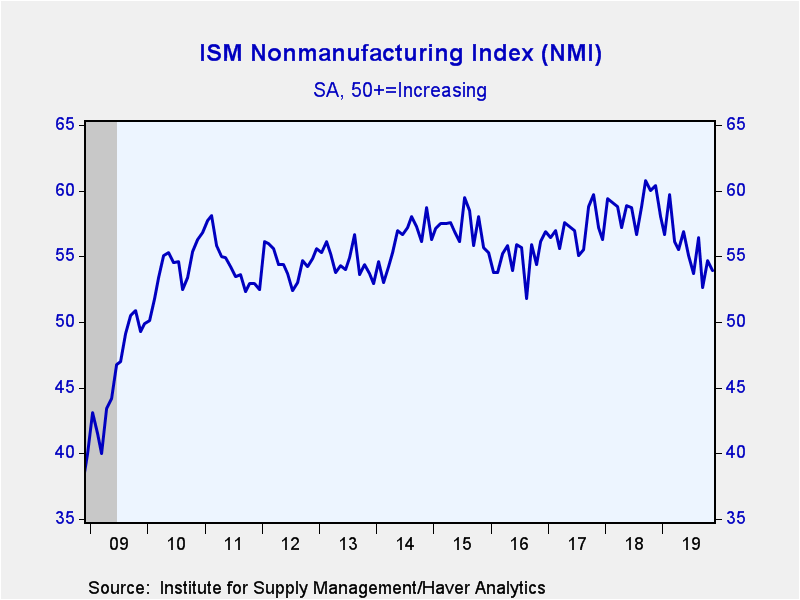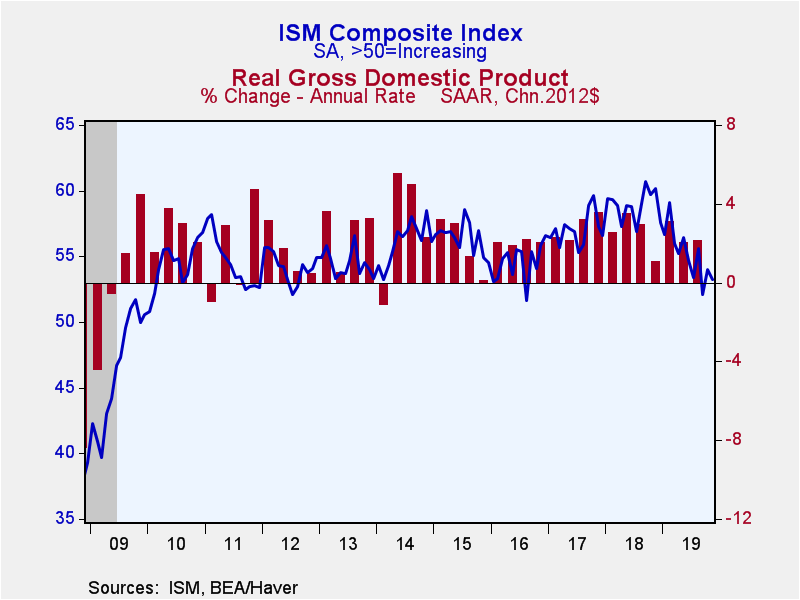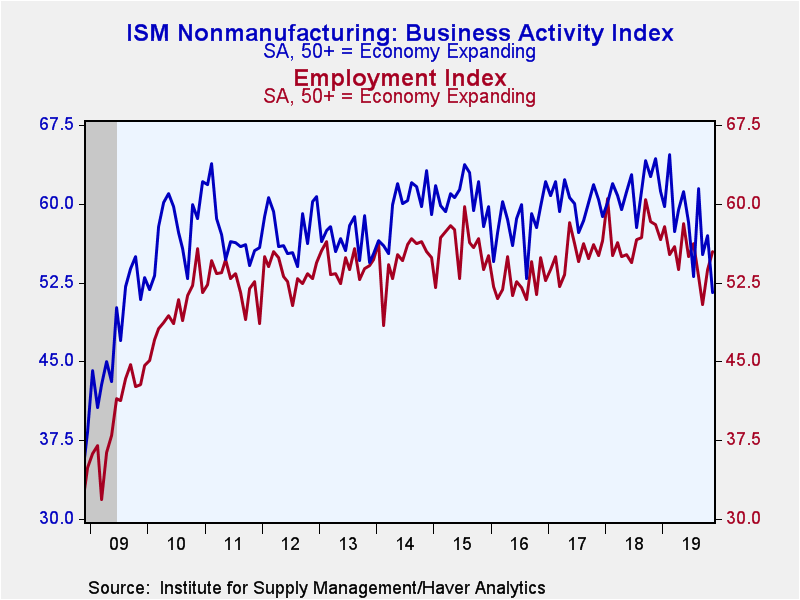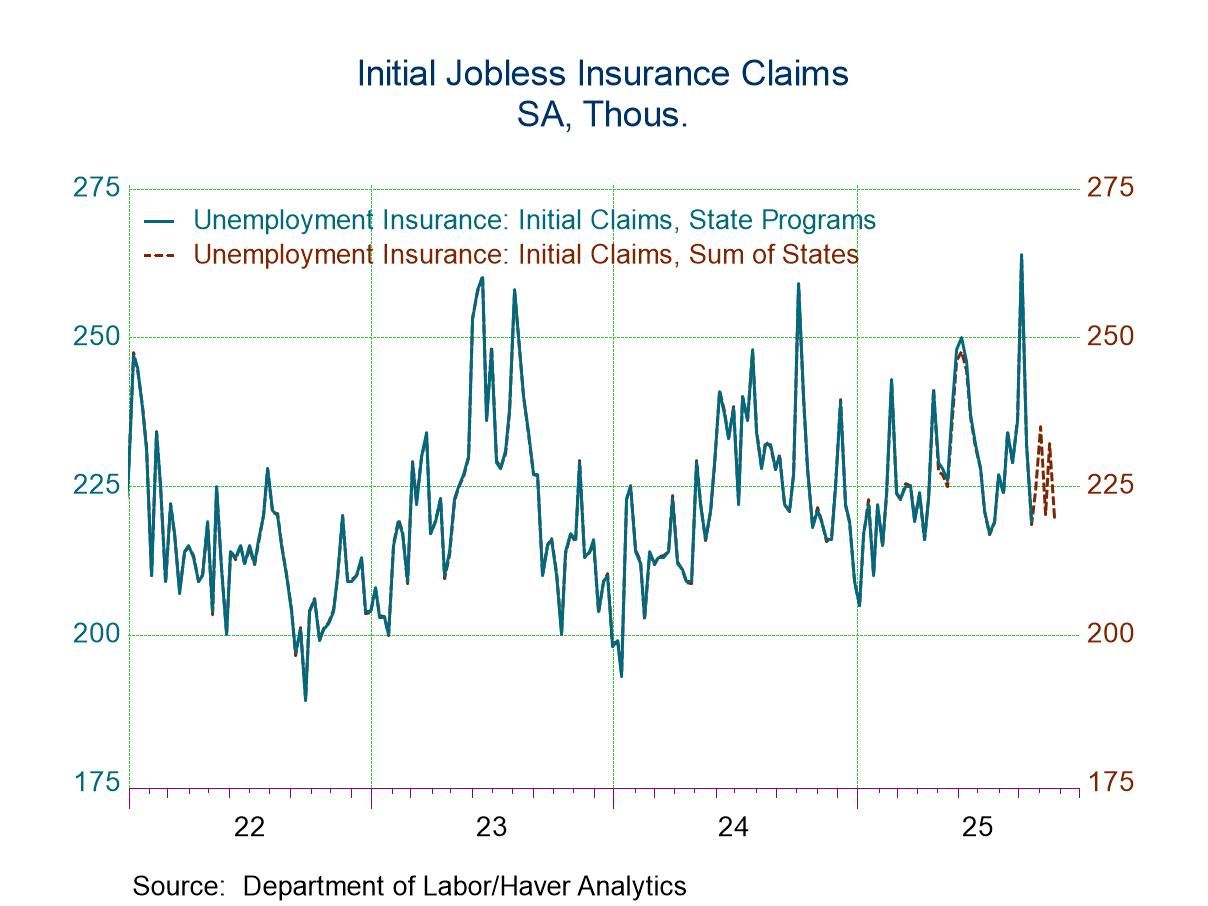 Global| Dec 04 2019
Global| Dec 04 2019U.S. ISM Nonmanufacturing Index Weakens
by:Tom Moeller
|in:Economy in Brief
Summary
The Composite Index of Nonmanufacturing Sector Activity from the Institute for Supply Management (ISM) declined to 53.9 during November from 54.7 in October. The figure compared to the high of 60.8 in September 2018. A reading of 54.5 [...]
The Composite Index of Nonmanufacturing Sector Activity from the Institute for Supply Management (ISM) declined to 53.9 during November from 54.7 in October. The figure compared to the high of 60.8 in September 2018. A reading of 54.5 had been expected in the Action Economics Forecast Survey. Readings above 50 indicate a rise in activity.
Haver constructs a Composite Index using this nonmanufacturing reading and the manufacturing series released Monday. The figure fell to 53.2 from 54.0 in October. During the last 15 years, there has been a 70% correlation between this index and the q/q change in real GDP.
The decline in the nonmanufacturing index reflected a lower Business Activity measure. It fell to 51.6 from 57.0 and was the lowest reading since July 2009. The Supplier Delivery measure also fell to 51.5 from 52.5. This reading was down sharply from last year, indicating faster delivery speeds.
Working higher was the New Orders measure to 57.1, though it remained below earlier highs. Hiring activity also improved as the Employment index rose to 55.5 from 53.7. It was the highest level since July.
The Prices index rose to 58.5 from 56.6. It has been moving sideways since the end of last year. Eighteen percent of respondents reported paying higher prices while six percent paid less.
The ISM figures are available in Haver's USECON database, with additional detail in the SURVEYS database. The expectations figure from Action Economics is in the AS1REPNA database.
| ISM Nonmanufacturing Survey (SA) | Nov | Oct | Sep | Nov'18 | 2018 | 2017 | 2016 |
|---|---|---|---|---|---|---|---|
| Composite Diffusion Index | 53.9 | 54.7 | 52.6 | 60.4 | 58.9 | 57.0 | 54.9 |
| Business Activity | 51.6 | 57.0 | 55.2 | 64.3 | 61.5 | 60.2 | 58.0 |
| New Orders | 57.1 | 55.6 | 53.7 | 62.7 | 61.3 | 59.3 | 57.6 |
| Employment | 55.5 | 53.7 | 50.4 | 58.0 | 56.9 | 55.1 | 52.5 |
| Supplier Deliveries (NSA) | 51.5 | 52.5 | 51.0 | 56.5 | 55.8 | 53.2 | 51.5 |
| Prices Index | 58.5 | 56.6 | 60.0 | 64.3 | 62.1 | 57.6 | 52.6 |
| ISM Manufacturing + Nonmanufacturing Composite (SA) | 53.2 | 54.0 | 52.1 | 60.2 | 58.9 | 57.0 | 54.5 |
Tom Moeller
AuthorMore in Author Profile »Prior to joining Haver Analytics in 2000, Mr. Moeller worked as the Economist at Chancellor Capital Management from 1985 to 1999. There, he developed comprehensive economic forecasts and interpreted economic data for equity and fixed income portfolio managers. Also at Chancellor, Mr. Moeller worked as an equity analyst and was responsible for researching and rating companies in the economically sensitive automobile and housing industries for investment in Chancellor’s equity portfolio. Prior to joining Chancellor, Mr. Moeller was an Economist at Citibank from 1979 to 1984. He also analyzed pricing behavior in the metals industry for the Council on Wage and Price Stability in Washington, D.C. In 1999, Mr. Moeller received the award for most accurate forecast from the Forecasters' Club of New York. From 1990 to 1992 he was President of the New York Association for Business Economists. Mr. Moeller earned an M.B.A. in Finance from Fordham University, where he graduated in 1987. He holds a Bachelor of Arts in Economics from George Washington University.










